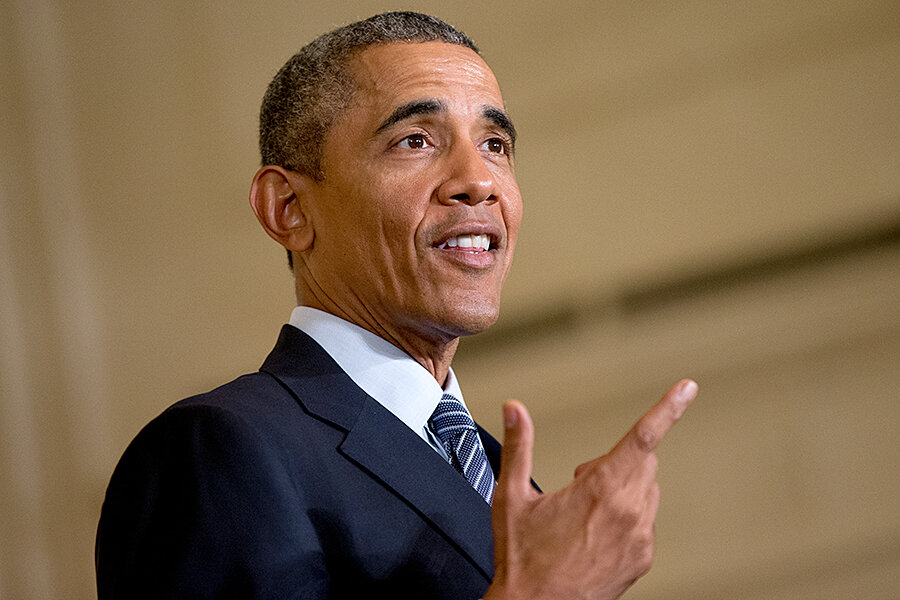Is US now a climate change leader? How Obama's new plan measures up.
Loading...
The Obama administration's new rules to reduce carbon-dioxide emissions from existing power plants have helped propel the United States to a leadership role in international efforts to curb global warming, some analysts suggest.
Monday's announcement of President Obama’s Clean Power Plan is being seen as a significant step forward for the US and for the international process.
"This is a case of leading by example," says Elliot Diringer, executive vice president of the Center for Climate and Energy Solutions, a climate- and energy-policy think tank in Arlington, Va. "The rest of the world has been waiting a long time for the US to demonstrate the kind of leadership we're seeing now."
The plan adds to the US's diplomatic credibility on climate, adds Andrew Deutz, director of international government relations for The Nature Conservancy. And that is as significant as the emissions goals, he suggests.
But how strict are the emissions goals themselves? Is the US on the verge of becoming a world leader in cutting carbon emissions?
There’s no easy way to compare the climate efforts of different nations, specialists say, because negotiators working on a Paris treaty are taking a "pledge and review" approach. Each country chooses its own targets, based on a range of factors.
The Clean Power Plan aims to cut CO2 emissions from existing power plants to 32 percent below 2005 levels by 2030. It is part of a broader Obama administration plan to cut carbon emissions economy-wide. The goal for that broader plan is to reduce all CO2 emissions to between 26 and 28 percent below 2005 levels by 2025.
The European Union, by contrast, aims to cut emissions 40 percent below 1990 levels – a more-aggressive target – by 2030. Some European countries not in the EU, such as Norway and Iceland, aim to at least match the EU targets. Switzerland aims for 50 percent cuts.
Meanwhile, China, Canada, New Zealand, Japan, and Singapore are using 2005 as the base year for their targets, like the US. Canada, New Zealand, and Japan have proposed emissions cuts of 25 to 30 percent by 2030. China and Singapore have pledged to significantly reduce their carbon intensity – the amount of carbon produced per unit of gross domestic product. Their goal is to see that their emissions peak by 2030.
Still others, such as Mexico, South Korea, Ethiopia, and Morocco, have set another, even softer baseline, offering to cut emissions between 32 and 64 percent, compared with what their emissions might have been in 2030 if emissions followed a "business as usual" path.
Of particular interest are India, Indonesia, Brazil, and South Africa, which have yet to submit plans, notes David Waskow, who heads the international climate initiative at the World Resources Institute in Washington. Along with China, these countries fall into a category of newly industrialized nations whose economic aspirations could lead to troubling emissions paths.
"People have tried to devise all sorts of formulas to suggest what an equitable distribution of effort would be," says Mr. Diringer. So far, none has stuck.
Still, Monday's announcement gives the US fresh credibility in dealing with climate change. This new credibility first emerged last November, says Mr. Deutz, when Mr. Obama and Chinese President Xi Jinping jointly announced their national offerings toward a new global climate pact during a summit in Beijing. For its part, China committed to capping emissions by 2030, with renewable energy sources accounting for 20 percent of the country's generating capacity. The country also would reduce its carbon intensity by 60 to 65 percent by 2030.
"That did a couple of things," Deutz says. "It put the US out there with a significant, credible target. It demonstrated that China was prepared to commit to an international target as well. And the fact that the US and China were moving together helped to unlock the negotiating space."
That played out in interesting ways a month later at global climate talks in Lima, Peru.
"Suddenly the US became a credible, positive force in the negotiations, getting a lot more respect than it had previously," he says. "It also meant that some countries that were hiding behind the US couldn't do that, and they were exposed."
Now, with the Clean Power Plan, which covers a sector of the economy responsible for 31 percent of the country's carbon emissions, the White House has added meat to the bones of its broader, international offering, Mr. Diringer says.
How all this plays out in Paris remains to be seen. Counting EU countries as a single entity, so far 22 countries have proposed their individual contributions to a new treaty. Taken together, these represent 56 percent of global emissions. But the commitments fall far short of what it would take to put the world on track to meet its current global-warming objective – holding global warming to 3.6 degrees Fahrenheit by 2100.
Many developing countries view as inadequate the emissions plans industrial countries have offered so far. Other difficult issues that don't involve emissions targets also remain to be solved.
And even with a fully operational Clean Power Plan, a new administration faces a lot of work to achieve the overall emissions reductions Obama has put forward to the Paris meeting of the United Nations Framework Convention on Climate Change, notes Alden Meyer, director of strategy and policy for the Union of Concerned Scientists in Washington.
Still, the Clean Power Plan represents "a very important step" in fulfilling the US's commitment, Mr. Meyer says. "Given the history at the state level with things like renewable-electricity standards and energy efficiency programs, we think it's quite likely that the US could overachieve the standard" in the Clean Power Plan.






